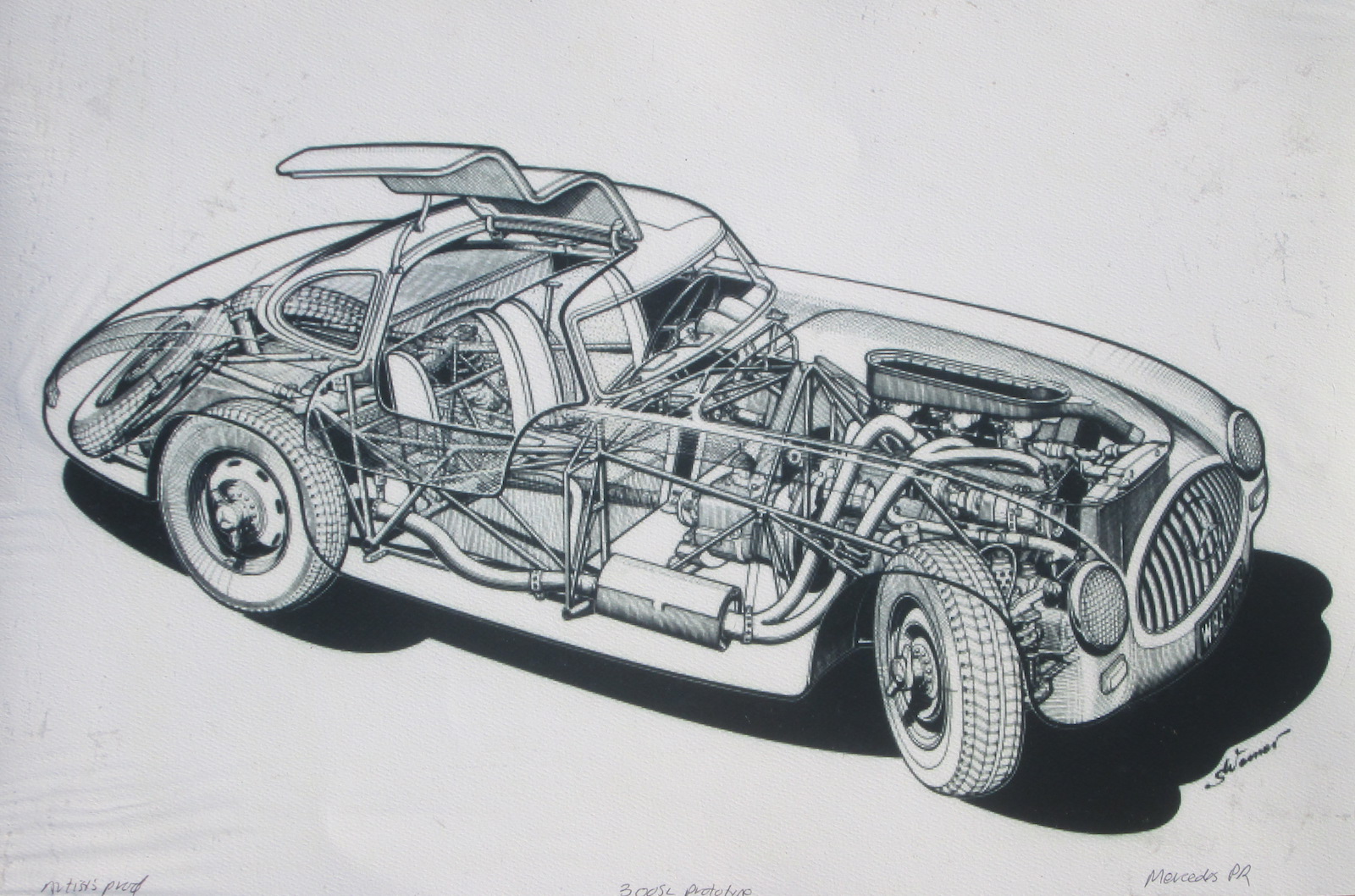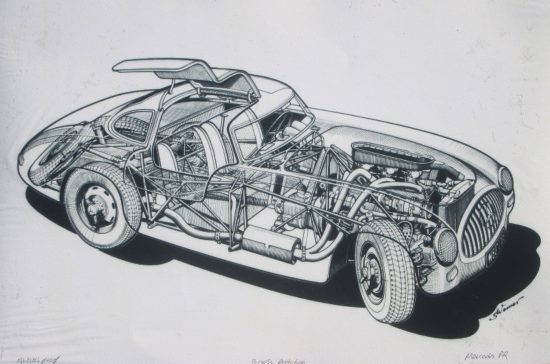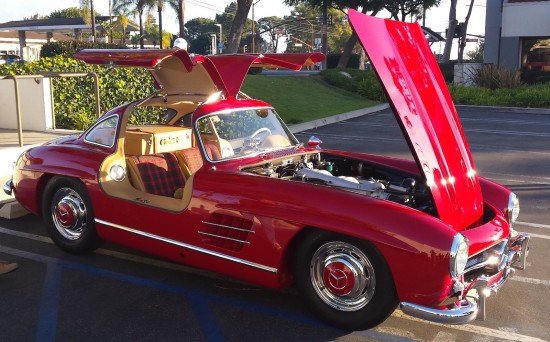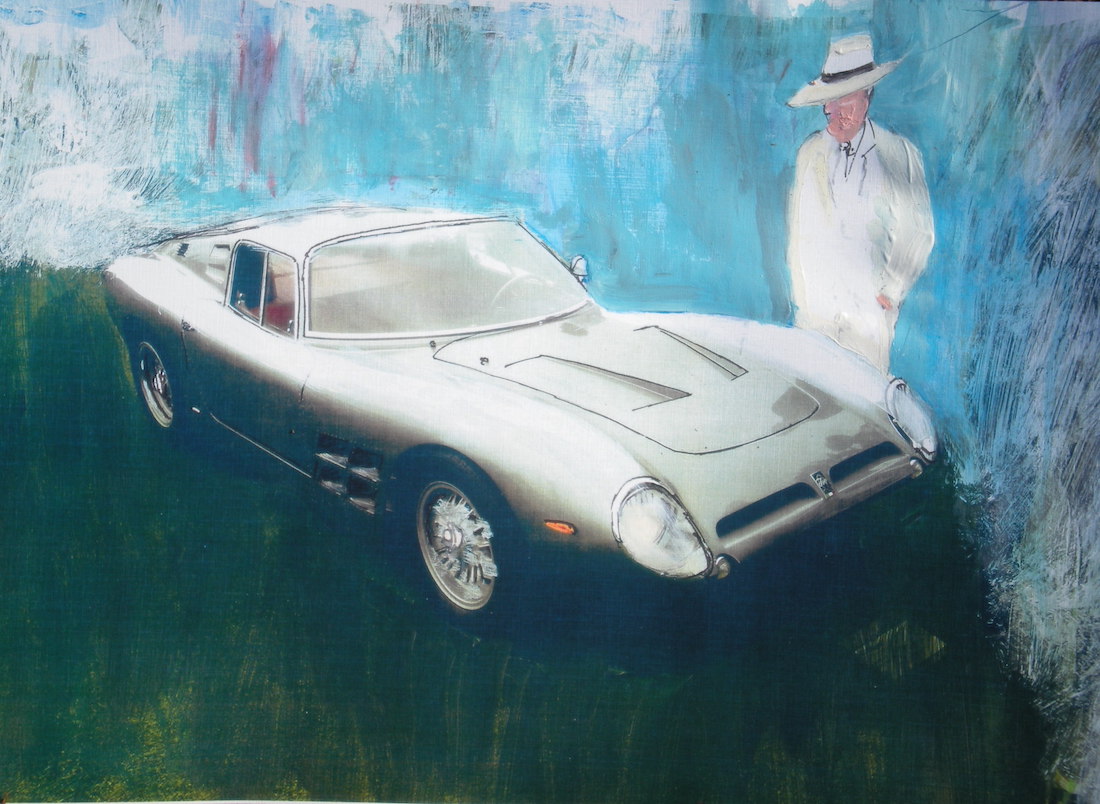by Wallace Wyss –
In writing my Incredible Barn Finds series of books (Enthusiast Books, Hudson WI), I come across a lot of happy stories—a guy who finds a potential million dollar car for peanuts.
But sometimes it’s a very sad story, where you come across a treasure and it gets away from you. And this is one of those. I’m even leaving the guy’s name out of this narrative on account of it must tick him off every time he sees a Gullwing Mercedes.
Here’s the story. You might know bit and pieces of the 300SL story so I’ll gloss over the background of the Gullwing.
The Mercedes 300SL was thought up by Mercedes in the early ‘50s. The block was from a sedan. The frame was a tubular bar space frame. The first ones looked like Porsche 356 coupes. The frame rose quite high into the door area so the solution was to cut the doors into the roof as on some aircraft.
The body on these first ones, made for racing, was all aluminum. The car was created for sports car racing, at the same time Mercedes was re-entering Formula 1 racing.
The first designation was W194, and that first car rolled out in March 1952 as the 300SL. The “SL” was for Super Leicht, or super light.
The first long-distance sports car road race on the 1952 schedule was the Mille Miglia, where they finished a close second to a Ferrari at the finish. A few weeks later, they showed their stuff, finishing in first, second, and third at Berne in a race before the GP race.
A car designed in only 18 months, it made history when it took its first race at Le Mans with Hermann Lang and Fritz Reiss driving, with one of the other 194s in second. This victory also marked the first time that a German-built car had ever won the 24 Hours of Le Mans.
Right after that some of the race cars were converted to roadsters and that’s where the trail gets muddled.
Probably by this time a little tired, the Le Mans winning car, 194/07 was shipped to Mexico as a PR car for the Carrera Panamericana race.
Long story short, following the Carrera, 194/07 was returned to Stuttgart. So one day this American racing photographer is visiting this flamboyant Mercedes engineer (how flamboyant, well, he had a yacht that was as fast as a speedboat and carried its own artillery) and says he wants a Gullwing and the engineer says something like: “Take this one, it’s one of our old test cars, and we will sell it cheap.”
It had a fuel injected six, so the photographer didn’t know it had originally had a 170-hp carbureted six.
Now all the time the photographer owns this car, driving it all over Yurrip, he keeps wondering “Why is my Gullwing different?” For instance, the damn shifter was under the dash. That even continued into ’54.
A Gullwing site says “Early 1954 cars, up to Chassis Number 4500050, have a long bent shift lever emanating from the forward part of the transmission tunnel, which eliminates the option of a radio”.
And then he tries to join the Gullwing Group. He submits his chassis number with his application. They say, in effect, “that ain’t no number of a Gullwing.” (For instance Briggs Cunningham got the first Gullwing made, chassis Number 198.0404500003.) I mean, would Mercedes lie to him? It looked like a 300SL. It drove like a 300SL. It was real. It was sitting in his driveway, for Chrissake. Yet it was not included in the total of 1,400 made.
Then the photographer smashes the car. Still drivable. He takes it back to MB. They say, glad to see ya, no sweat, here, take this body, and oh, hope you don’t mind, it’s aluminum (like the 29 factory alloy Gullwings). Turns out the alloy ones didn’t sell that well, so they got leftover bodies.
The photographer takes it to America, to California. He finally sells it. I distinctly remember reading the ad myself, in the Road & Track classifieds. I pass on it, thinking it’s got no bumpers (I bought my first one, with bumpers, for $4,000 in ’66).
So he sells it, I think the advertised price was $6,500.
Decades pass. Then some foreigner publishes a book that lists the SN of all the cars that ever won Le Mans. Damned if his Gullwing’s chassis number isn’t there–194/07.
Of course now it is several owners later. The owner who finally brings it back to its ’52 Le Mans bodywork is megarich and can afford to do it right. Ever hear of wireless? Enough said.
He even is able to find an engine from the ’52 race, No. 194/21, from the other Gullwing that raced at Le Mans that year and the only known original-type 194 engine in private ownership. Then he has it fitted with a body exactly like it raced with in ’52.
And the beauty of it all is that Mercedes is overjoyed the car has been found and restored with no holds barred and co-operates in every way. They even borrow it for events like demonstration rides for the press at the launch of the SLS AMG in Mexico and of course it makes the important Concours like the one at Amelia Island.
Now I could reproduce that Road & Track ad from many decades ago to go along with this story, but I’m not doing so. It hurts too much (I sold my Gullwings for a song too…). But there’s a lesson to be learned there, (I like to put a “lesson learned” at the end of each chapter of my barn find books) and in this case, it is investigate your car’s history. That rhinestone you bought at the swap meet might actually be a diamond underneath….
Let us know what you think in the Comments.
THE AUTHOR: Wallace Wyss, who also wears the beret of a fine artist, recently opened a website, Wallace Wyss Fine Art, featuring his artwork on collector cars.





I drove to Waco to be in the “Ice Sickle Grand Prix” which was a Gymkhana of the times in 1966 and there were a gaggle of sports cars of all makes. A Sunbean “Tiger” with the small block Ford which was fast but too nose heave, a Corvette of the 327 c.i. flavor, a 356 SC Porsche and a student from Baylor University arrived in a 300SL “Gull Wing” Coupe. he showed me his car as I had never seen one up close and then offered to take me for a ride around the race course. The “Gull Wing” had a ventilation problem so as we motored around the drive cracked the “Gull Wing” doors allowing the air to come in and circulate. The car had a fuel injected “Six” that was great in the fifties. I think Mercedes held sway over the Ferraris in the “Tour de France” of the mid fifties, however by 1966 the big American V-8 held sway. Another interesting car of that day was an old J-2 Allard with a relatively new Ford 406 c.i. that had been dropped in to replace a blown mill. I am just wondering if any enthusiast in the Waco, Texas area who might have taken pictures. I would love to buy them. There were a bevy of one of a kind cars that will never come again. I loved the 300 SL. the Germans really pay attention to their cars.
I recall an article on the Icicle/Ice Sickle Grand Prix…and I seem to recall Denise McCluggage was involved…but can’t find it.
Altho I did find this one: http://www.calconnect.com/cars/corvair_experiences/corvair_experiences.htm
Will keep looking…
Yep, ole’ Jesse’s Mercedes. It even had the new rear suspension from the roadster, and a wooden wheel from the racing department. Have dreamed about this particular Gullwing for years. Kept the Road &Track ad for this car like, forever. Think this car ended up in Texas for a while. The Beatles sang “all you need is love” but I know for a fact that all you need is money! If not for the fact that I was a penny-less high school kid I would have bought the car.
They actually needed to use the gullwing doors, because they could not cut down for lower door openings, because that lower part was a major structural part of the frame and integral to it rigidity. If they had cut out that lower part of the car to make conventional doors, the car would not have been structurally sound and would have flexed so much as to fall apart.